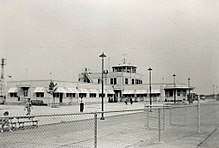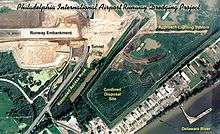Aviation in Pennsylvania
Aviation in Pennsylvania dates back over 100 years. Pennsylvania ranks 11th in the country in the number of public-use aviation facilities with 130 airports, heliports and seaplane bases. The 130 public-use facilities provide an annual economic impact of $23.6 billion to the state. The aviation industry also supports more than 300,000 jobs making it one of the largest employment sectors in the state.[1]
.jpg)
The state has multiple major international airport that connect to state and surrounding areas. Philadelphia International Airport and Pittsburgh International Airport account for a majority of passenger numbers including about three million international travelers to Europe and the Middle East.
History
Aviation in the Commonwealth of Pennsylvania dates back over 100 years. The state has been in the for front of the aviation development and growth. In the early 1900s the state was home to substantial growth.
Industry beginnings
After the Wright brothers first flight the opportunity of flight raced across the nation. Especially in Pennsylvania, many inventors began working on designs for their own flying machines. The public thought flying was abnormal. So these inventors across the state held public air shows to show off their machines to the public and media. Around this time in the 1910s and 1920s many of the states airports were founded. Thus thrusting the aviation industry into the spotlight across the state.
During war time

During the World Wars specifically World War II Pennsylvania was designed by the United States Army and United States Air Force as training skies for bomber and fighter pilots prior to deployment to Europe or Asia. These bases include Fort Indiantown Gap, Pittsburgh Air Reserve Station and Harrisburg International Airport.[2] Also during this time the Air Force built their bombers in locations throughout the state.
Modern commercial aviation
_JP5958132.jpg)
As jet travel began to become more and more popular, the airline choices expanded as well. The states airport saw record numbers during the 60s and 70s. Massive numbers of aircraft, flights, passengers and airlines at Pennsylvania's airports. Especially at the states two largest airports, Philadelphia International Airport the largest and the gateway to Europe and Pittsburgh International Airport a then hub for US Airways a more domestic airport with some flights to Canada and Latin America. All airports saw dramatic rise in flights and passengers in the 70s, 80s and 90s. But after the September 11th attacks much like the rest of the country Pennsylvania's airports saw huge decline in passenger numbers. Thus causing airlines to pull out, such as British Airways in Pittsburgh and KLM at Philadelphia's airport.[3]
Continued growth and industry expansion

Many airports in the commonwealth are seeing growth. In turn, facilities and infrastructure is being updated or constructed. Since 2011 the FAA along with local, state and Federal governments allotted almost $1 billions to aviation infrastructure at the states airports. Most predominantly at Philadelphia International Airport, Wilkes-Barre/Scranton International Airport and Williamsport Regional Airport.
Major airports
Major airports in Pennsylvania with over 25,000 reported passengers to FAA.
| Airport | City | Passengers | Aircraft movements |
|---|---|---|---|
| Philadelphia International Airport | Philadelphia | 31,444,403 | 411,368 |
| Pittsburgh International Airport | Pittsburgh | 8,309,754 | 144,563 |
| Harrisburg International Airport | Harrisburg | 1,173,938 | 47,289 |
| Lehigh Valley International Airport | Allentown | 638,000 | 77,978 |
| Wilkes-Barre/Scranton International Airport | Wilkes-Barre / Scranton | 469,000 | 49,863 |
| Arnold Palmer Regional Airport | Latrobe | 287,000 | 28,816 |
| Erie International Airport | Erie | 88,953 | N/A |
| Williamsport Regional Airport | Williamsport | 25,119 | 33,019 |
| 42,436,167 | 792,896 |
Notable aviation companies
The following are notable aviation manufacturers, suppliers and airlines based in Pennsylvania.
- Air East — commuter airline
- Altair Airlines — now defunct airline
- Boeing Rotorcraft Systems — headquarters and main factory near Philadelphia
- Fly Advanced — charter airline
- Lycoming Engines — aircraft engine manufacturer
- Sawdust Airlines — airline
- USA3000 Airlines — now defunct airline
Airliner accidents within Pennsylvania
Click on flight number for accident page.
| Date | Flight Number | Airline | Fatalities | Survivors | Location | Summary |
|---|---|---|---|---|---|---|
| April 7, 1936 | 1 | TWA | 12 | 2 | Wharton Township, Pennsylvania | Pilot error |
| March 25, 1937 | 15A | TWA | 13 | 0 | Upper St. Clair Township, Pennsylvania | Icing causing loss of control |
| April 1, 1956 | 400 | TWA | 22 | 14 | Moon Township, Pennsylvania | Mechanical failure followed by pilot error |
| June 23, 1967 | 40 | Mohawk Airlines | 34 | 0 | Blossburg, Pennsylvania | Mechanical failure causing; structural fire then loss of control |
| December 24, 1968 | 736 | Allegheny Airlines | 20 | 27 | Bradford, Pennsylvania | Pilot error; controlled flight into terrain |
| January 6, 1969 | 737 | Allegheny Airlines | 11 | 17 | Lafayette Township, Pennsylvania | Pilot error; controlled flight into terrain |
| January 6, 1974 | 317 | Air East | 12 | 5 | Richland Township, Pennsylvania | Failure to maintain flying speed; Improper IFR operation; Premature descent below safe approach slope |
| September 8, 1994 | 427 | USAir | 132 | 0 | Hopewell Township, Pennsylvania | Rudder hardover |
| September 11, 2001 | 93 | United Airlines | 44 | 0 | Stonycreek Township, Pennsylvania | Terrorist hijacking |
| April 17, 2018 | 1380 | Southwest Airlines | 1 | 148 | Over Pennsylvania; landed at Philadelphia International Airport | Engine failure followed by decompression |
References
- "Aviation - PENNDOT.gov". PennDOT.gov. Retrieved 5 August 2017.
- "Air Force bases Pennsylvania". Military Bases. Retrieved 6 August 2017.
- "aviation history in Pennsylvania". AAz. 9 July 2011. Retrieved 6 August 2017.